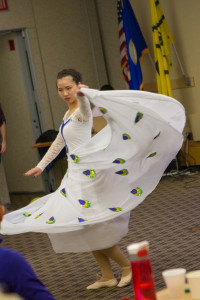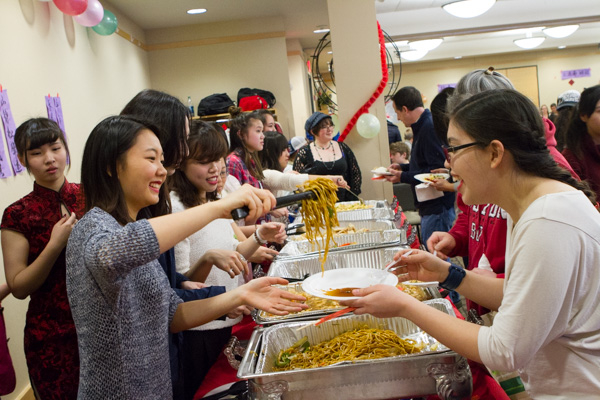The Lunar New Year Celebration took place last Saturday, Feb. 21 to celebrate ancient traditions and practices with food, performances and music for the “Year of the Goat.”
The celebration is also called Spring Festival. The true New Year began Feb. 19, though the campus celebration took place two days later.
Traditionally in China, in preparation for the New Year, many different events and activities take place starting at the end of December and continue well into January. Each day during this time period, there are different activities and rituals that take place to complete the process. These preparations are supposed to bring good luck in the New Year.
“When the clock reaches the New Year, we run outside and set off fireworks.”—Sharron Wang
2015 is the Year of the Goat (or Sheep). This comes from the Chinese tradition of zodiacs. A zodiac is a specific animal that represents one specific year. There are twelve zodiacs, each with different meanings and characteristics. The goat is gentle, calm, thoughtful and honest.
Sophomore Jessie Tan took part in organizing and setting up the festival. She has celebrated the Spring Festival with her family in the past and brings the traditions to Gustavus.
“Chinese people believe that people’s zodiacs have certain personality traits that fit the person born in that year,” Tan said.
Sophomore Sharron Wang has been instrumental in planning the event. She is the leader of Global China Connection (GCC).
“In Chinese, New Year is ‘Guo Nian.’ Guo means to pass; Nian means year,” Wang said.
There are a lot of legends and history behind the festival that have been a part of the festival for many years. Wang grew up hearing one particular legend explaining some traditions for the festival.
“One story I was told when I was young was that in ancient China there was a monster named ‘Nian’ that lived in the countryside and ate babies. One day in the lunar year, the Chinese people would set off fireworks so they could pass the monster. They would set off the fireworks to protect their children and all of the crops in the land. That is where the name is from. ‘Guo nian’ means to ‘get rid of the monster’,” Wang said.
Wang explained that some of the ancient traditions have been adapted into modern day Chinese culture to celebrate the New Year.
“We watch the ‘Chinese New Year Gala’ on television. Everybody watches the clock and we count down. When the clock reaches the New Year, we run outside and set off fireworks,” Wang said.
Another tradition involves “red bags,” something that children look forward to each year.
“Children ask for money from the older generations. We say some good words to them and they give us money in the red bags. It’s everybody’s favorite part,” Wang said.
“This is the time for family reunion and for pilgrims when we would forget and laugh at all the troubles and bad luck that we had during the previous year and think positively about the future.”—Kimmie Hoang
First year Kimmie Hoang, who grew up in Vietnam, says China has influenced many other countries in Asia in their lunar traditions, but there are distinct differences.
“Every country has its own way of practicing the customs and traditions. We eat different things, wear different kinds of clothes, and decorate the house and the street with different things. We have different myths and folklore stories to tell too,” Hoang said.
Food is an important part of the New Year across different countries’ borders. Families gather to make and eat food together.
“My favorite part of the lunar celebration is the Feast of the First Morning of the First Day. We have different kind of traditional foods, candies, and fruits. We also have a lot of customs involved in this special first morning of the year. There would be fireworks early in the morning, ancestral worshipping, wishing New Year’s greetings, and giving lucky money to children and elderly people,” Hoang said.
Traditional foods are prepared for this celebration. For the Gustavus celebration, food was catered to account for the large amount of people interested in celebrating.
“One tradition is making dumplings. It’s important to make dumplings with your family so you can feel like you are with them and are not alone. For Chinese people it’s an important day to eat well,” Tan said.
At Gustavus’ celebration of the Lunar New Year, a variety of activities took place that celebrated these lasting traditions and brought the culture to the campus.
“There were a lot of interesting game sessions which a lot of people in the Chinese countryside play during the Lantern Festival in January,” Wang said.
Performances by many different students took place throughout the evening. These displayed the different cultures and traditions.
“There are performances involving singing and dancing with traditions coming from China and Vietnam. It is somewhat similar to the International Festival, but this is more focused on Lunar New Year culture,” Tan said.
All in all, bringing in the New Year is an exciting and hopeful time for those who celebrate it.
“This is the time for family reunion and for pilgrims, when we would forget and laugh at all the troubles and bad luck that we had during the previous year and think positively about the future,” Hoang said.
For more information on the Lunar Festival, contact Sharron Wang.
-Laura Isdahl

